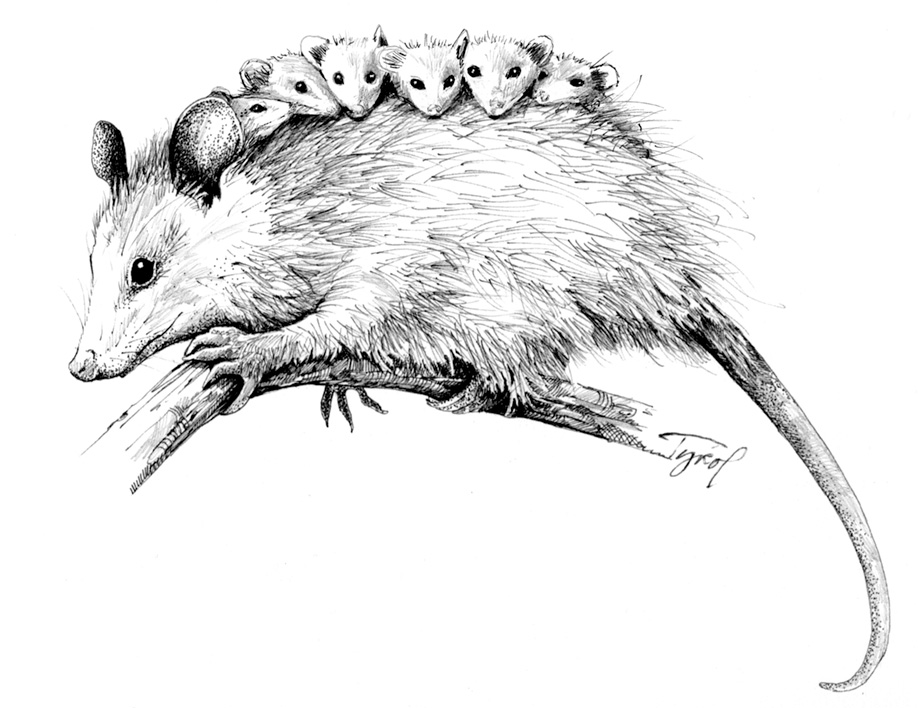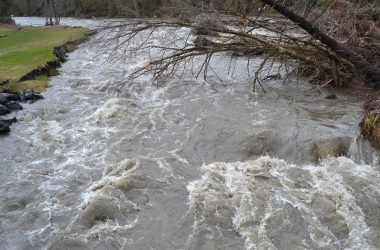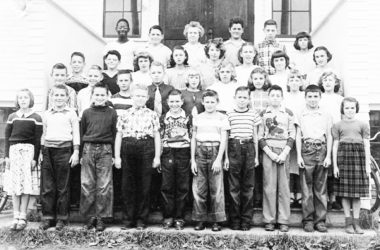
by Susan Shea
BROOKFIELD – Years ago, when I worked at a nature center in Connecticut licensed to care for injured and orphaned wildlife, a baby opossum was brought to us. It was found lying on a golf course, and was too young to be on its own. We named the opossum Alice and estimated it was nine weeks old. Although we later determined the opossum was a male, the name stuck.
Virginia opossums are North America’s only native marsupials, or pouched mammals, and are related to kangaroos and wallabies. Marsupials have a short gestation period, and the young are born underdeveloped and finish growing in the female’s abdominal pouch. Alice arrived at our center in September and was likely born in early July, just 13 days after his mother had mated and conceived. In southern New England, opossums often have two annual litters, and he was probably part of a second litter of 5 to 13 young. (In northern states, opossums bear one litter per year). At birth, Alice and his siblings were less than a half-inch long, the size of honeybees. They were pink, hairless, had no visible ears, and their eyes were just dark spots beneath the skin. Their hind feet and tails were stubs, but their front paws were fully developed with claws.
Immediately after birth, baby opossums climb upwards and into their mother’s pouch and attach to one of her 13 nipples. The nipple expands to fill the baby’s mouth, holding it in place. Young opossums remain in this warm, protective incubator lined with soft fur, fastened to a nipple, for six to seven weeks. They grow coarse gray fur; soft, leathery ears; a long, scaly tail; and their hind feet finish developing. As the babies became larger, the mother’s pouch stretches to accommodate them.
Baby opossums open their eyes at eight weeks and begin to leave the pouch for short periods and crawl around the den, often an old woodchuck burrow. Some ride on their mother’s back, clinging to her fur with their feet and tails, as she wanders about searching for food at night. Perhaps Alice fell off this baby carriage as his mother bolted to escape a predator.
When the young opossum arrived at the nature center, he needed to be fed a milk formula from an eyedropper every few hours, so I took him home at night and on weekends. At first he lived in a covered cardboard box with a heating pad underneath, as he could not yet thermoregulate.
While raising Alice, I observed many interesting behaviors. After he was able to climb out of the box and wander around my apartment, I would sometimes feel a tug on my nightgown as he crawled up and nestled against my side underneath my bathrobe. This must have felt similar to a pouch, which he still would have been using if he had not lost his mother.
Alice dug in the box of facial tissue on the floor beside my bed, crumpling up the tissue. He then wrapped his tail around the tissue and carried it around. In the wild, opossums carry nesting material such as leaves this way. Alice was also an adept climber, and one day I came home to find him on the top shelf of my closet. He had crawled up via the leaning guitar, hanging clothes, and coat hangers, using his paws and prehensile tail, as he would ascend a tree in the wild. Alice regularly played with the bathroom wastebasket, knocking it over and clinging to the inside or outside as it rolled back and forth. He made several sounds: one a screech when he was startled or wanted my attention, another a soft whistling when he was excited.
At 14 weeks of age, Alice was weaned and eating solid food. By then it was late October, and he wouldn’t have stood much chance of surviving the winter in the wild. We kept him in a cage at the nature center, letting him out in the building for daily exercise. In springtime, I began taking Alice for walks in the woods and acclimated him to wild foods such as fruit, raw eggs, and dead mice. Eventually we released him on the center’s property, which had the diverse mix of habitat opossums thrive in. He disappeared into a hole under a rock without a backward glance. I was glad to return him to the wild where he belonged and grateful for the window into an opossum’s world that he gave me.
[Susan Shea is a naturalist, writer, and conservationist based in Vermont. Illustration by Adelaide Murphy Tyrol.]






